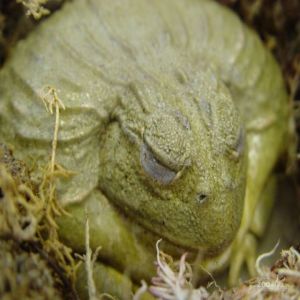 The African Bullfrog is the largest amphibian found in southern Africa. The males average 23 cm (9 inches) and weigh 1.4 kg (3.1 lb) but can easily exceed 2 kg (4.4 lb). The female are half the size of the males. Males are olive in color, with yellow to orange on the throat region. Females are olive to light brown with cream to white throat areas. Both sexes have ridges running laterally on the dorsal surface. They have a spade-like metatarsal tubercle on each hind foot to aid in digging. During the dry season the frogs live underground.
The African Bullfrog is the largest amphibian found in southern Africa. The males average 23 cm (9 inches) and weigh 1.4 kg (3.1 lb) but can easily exceed 2 kg (4.4 lb). The female are half the size of the males. Males are olive in color, with yellow to orange on the throat region. Females are olive to light brown with cream to white throat areas. Both sexes have ridges running laterally on the dorsal surface. They have a spade-like metatarsal tubercle on each hind foot to aid in digging. During the dry season the frogs live underground.
Location: Education Animals
Share:
Range
Angola, Botswana, Kenya, Malawi, Mozambique, Namibia, Somalia, South Africa, Swaziland, Tanzania, Republic of Zambia, Democratic Republic of the Congo, and Zimbabwe
Habitat
African Bullfrogs can tolerate some of the harshest environments in Africa. They are found in drier savannas in pools, pans, and ditches that fill with water during rains. It has been found from the Kalahari Desert to the Highveld area between 1200 and 1500 meters above the sea level.
Conservation Status
Least Concern
Primary Threats
Human-Wildlife Conflict. Residential and Commercial Development. Hunting and Trapping. Pet Trade.
Gestation
2 days (emerge as tadpoles) and then undergo metamorphosis in three weeks.
Litter
The female may release up to 4000 eggs.
Behavior
Since the African Bullfrog can live in extreme conditions, their behavior depends on the weather. When it is dry or extremely cold, they live underground in an estivating chamber waiting for more suitable conditions. The majority of their lives are spent estivating underground. They slough off several layers of their skin’s epidermal cells to form a tough cocoon, which prevents the evaporation of body fluids. Most of their bodily functions slow or shut down altogether. They absorb water stored in their bladder. This period of dormancy may last a year or more.
Reproduction
Breeding starts after a heavy rain. They breed in shallow, temporary waterbodies. Eggs are laid in the shallow edge of the pond, with fertilization taking place above the water level. The males exhibit parental care. They watch over and defend the eggs which hatch in 2 days. After hatching, the tadpoles will feed on each other, as well as on small fish and invertebrates. The defending male will continue to watch over the tadpoles until they undergo metamorphism within 3 weeks. If the pool is endangered of drying out, the male will dig a channel to a larger body of water.
Wild Diet
Insects, small rodents, reptiles, small birds, and other amphibians.
Zoo Diet

